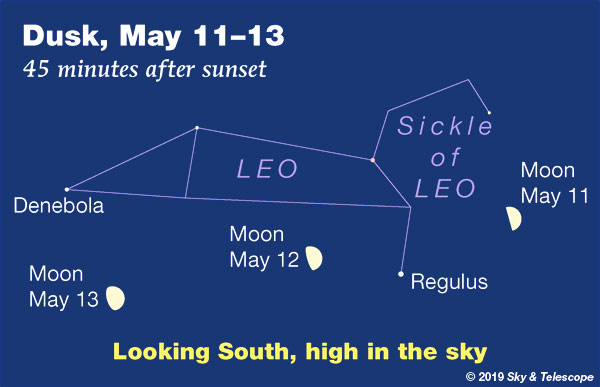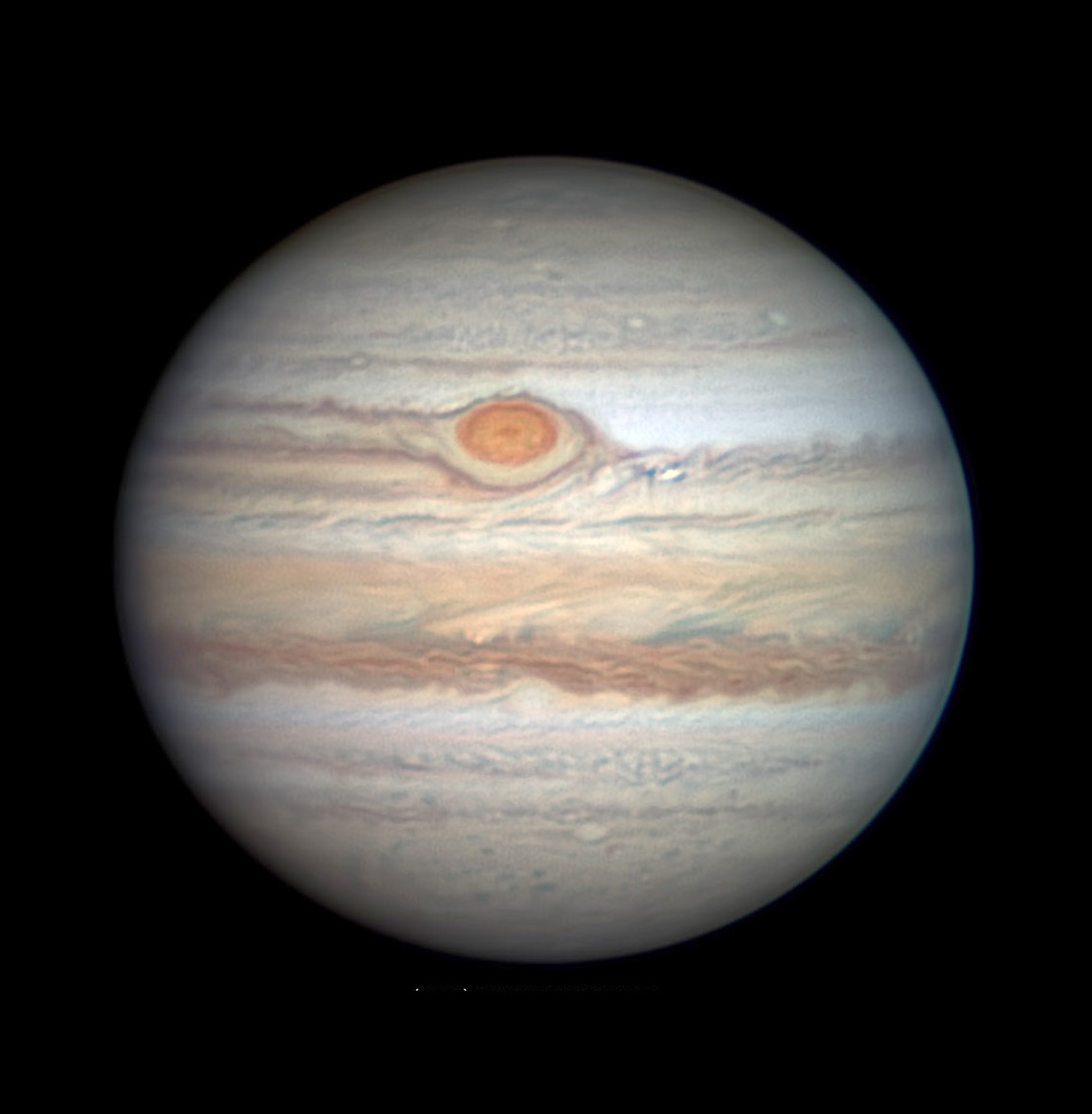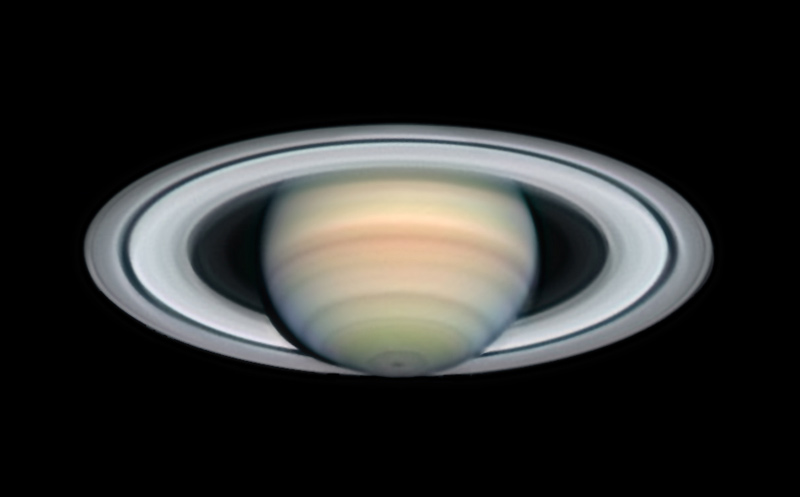Friday, May 10
• The Moon, nearly first quarter, crosses the Beehive star cluster (M44) this evening for much of North America. Many faint occultations will be visible telescopically on the Moon's dark limb, writes David Dunham: "Occultations of 6th to 9th-magnitude stars in rapid succession will occur as the 39% sunlit Moon passes over M44, visible in part from most of North America east of the Rocky Mountains, with northeastern areas favored. A Moonview and information about computing local predictions is on the IOTA occultation campaigns page." (The Universal Time date is May 11th.) See our article The Moon Bumbles Into the Beehive.

Saturday, May 11
• First-quarter Moon (exact at 9:12 p.m. Eastern Daylight Time). The Moon shines some 10° to the right of Regulus. Above Regulus is Algieba (Gamma Leonis), only a little fainter. They're the two brightest stars of the Sickle of Leo.
Sunday, May 12
• As night descends, look west for Pollux and Castor lined up almost horizontally (depending on your latitude). These heads of the Gemini twins form the top of the enormous Arch of Spring. To their lower left is Procyon, the left end of the Arch. Farther to their lower right is the other end, formed by Menkalinan (Beta Aurigae) and then brilliant Capella.
Monday, May 13
• Look above the Moon this evening for Denebola (Beta Leonis), the tail tip of Leo.
You'll find bright Arcturus way off to Denebola's left, by three or four fists at arm's length.
Tuesday, May 14
• Vega is now well up in the east-northeast after dark. Look for its faint little constellation Lyra, the Lyre, hanging down from it.
Wednesday, May 15
• The star below the gibbous Moon this evening is Spica. Even in the largest telescopes Spica appears single, but it's actually a close binary pair of two brilliant, ellipsoidal blue giants that barely eclipse tiny edges of each other once per orbit. See Meet Spica, the Ear of Grain.
Upper left of the Moon and Spica is brighter Arcturus, a single orange giant star.
Lower right of Spica (by half its distance from Arcturus) is four-star sail shape of Corvus, the Crow.
Thursday, May 16
• Now the Spica shines to the right of the Moon.
Friday, May 17
• The Moon, nearly full, shines in dim Libra. Binoculars will help you see through the moonlight to Beta Librae nearly 5° to the Moon's upper left (for North America), and Alpha Librae a similar distance to the Moon's lower right. Alpha is an easy binocular double star.
Arcturus shines very high above the Moon. Less far to the Moon's right or upper right you'll find Spica, one magnitude fainter.
Saturday, May 18
• Full Moon (exact at 5:11 p.m. Eastern Daylight Time). The Moon rises around sunset. After dark, it shines above the rising head of Scorpius.
________________________
Want to become a better astronomer? Learn your way around the constellations. They're the key to locating everything fainter and deeper to hunt with binoculars or a telescope.
This is an outdoor nature hobby. For an easy-to-use constellation guide covering the whole evening sky, use the big monthly map in the center of each issue of Sky & Telescope, the essential guide to astronomy.

Once you get a telescope, to put it to good use you'll need a detailed, large-scale sky atlas (set of charts). The basic standard is the Pocket Sky Atlas (in either the original or Jumbo Edition), which shows stars to magnitude 7.6.
Next up is the larger and deeper Sky Atlas 2000.0, plotting stars to magnitude 8.5; nearly three times as many. The next up, once you know your way around, are the even larger Interstellarum atlas (stars to magnitude 9.5) and Uranometria 2000.0 (stars to magnitude 9.75). And read how to use sky charts with a telescope.
You'll also want a good deep-sky guidebook, such as Sue French's Deep-Sky Wonders collection (which includes its own charts), Sky Atlas 2000.0 Companion by Strong and Sinnott, or the bigger Night Sky Observer's Guide by Kepple and Sanner.
Can a computerized telescope replace charts? Not for beginners, I don't think, and not on mounts and tripods that are less than top-quality mechanically (meaning heavy and expensive). And as Terence Dickinson and Alan Dyer say in their Backyard Astronomer's Guide, "A full appreciation of the universe cannot come without developing the skills to find things in the sky and understanding how the sky works. This knowledge comes only by spending time under the stars with star maps in hand."


Mercury is hidden in the glare of the Sun.
Venus (magnitude –3.8) is very low in bright dawn. Just 20 minutes or so before sunrise, look for it a little above the horizon due east. Bring binoculars.
Mars (magnitude +1.7, in Taurus) is low in the west during and after dusk. Look for it far lower right of Castor and Pollux and lower left of Capella. Don't confuse Mars with similarly faint Beta Tauri to its lower right, or Gamma Geminorum farther to Mars's left.
Jupiter (magnitude –2.5, in the eastern leg of Ophiuchus) rises in the southeast around 10 or 11 p.m. daylight-saving time. It shines highest in the south around 3 a.m., well before dawn begins, with orange Antares twinkling 14° to its lower right.
In a telescope Jupiter has grown to a good 44 arcseconds wide as it approaches its June 10th opposition. See Richard Jakiel's Jupiter observing guide in the May Sky & Telescope, page 52.
Saturn (magnitude +0.4, in Sagittarius) rises around midnight or 1 a.m. Before dawn, it's the steady, pale yellowish "star" 28° (about three fists at arm's length) left of Jupiter.
Uranus is hidden deep in the glow of dawn.
Neptune is very low in the east-southeast before dawn begins.
______________________
All descriptions that relate to your horizon — including the words up, down, right, and left — are written for the world's mid-northern latitudes. Descriptions that also depend on longitude (mainly Moon positions) are for North America.
Eastern Daylight Time (EDT) is Universal Time (UT, UTC, GMT, or Z time) minus 4 hours.
______________________
Audio sky tour. Out under the evening sky with your earbuds in place, listen to Kelly Beatty's monthly podcast tour of the heavens above. It's free.
______________________
“This adventure is made possible by generations of searchers strictly adhering to a simple set of rules. Test ideas by experiments and observations. Build on those ideas that pass the test. Reject the ones that fail. Follow the evidence wherever it leads, and question everything. Accept these terms, and the cosmos is yours.”
— Neil deGrasse Tyson, 2014
______________________
 4
4








Comments
VICTORSUNSTAR
May 10, 2019 at 12:25 pm
Well what I do with Corvis and Spica...
I draw a straight line from Spica thru the two top stars of Corvis. Corvis then becomes a flag on that flagpole - hanging down towards the south. I then in my imagination see that that flag is waving down to Crux... Also I turned Orion into Bart the Simpson and Leo into Garfield the Cat... and... The Big Dipper into a large cell phone with a bent antenna... fun...
You must be logged in to post a comment.
Rod
May 10, 2019 at 3:56 pm
Victorsunstar, this is great! LOL 🙂
You must be logged in to post a comment.
misha17
May 10, 2019 at 5:57 pm
The full moon on May 18th fits the Maine Farmer's Almanac's original definition of a "Blue Moon" - the 3rd, or "extra" full moon in a season having 4 full moons.
+ A couple of previous S&T articles about seasonal "Blue Moons" -
"A True-Blue 'Blue Moon'"
August 2013
https://skyandtelescope.org/astronomy-news/observing-news/a-true-blue-blue-moon/
"What Is A Blue Moon?"
July 2006
https://skyandtelescope.org/observing/celestial-objects-to-watch/what-is-a-blue-moon/
+ search results for "Blue Moon" articles (and photos), both calendar (2 full moons in a month) and seasonal (4 full moons in 1 season) -
https://skyandtelescope.org/?s=Blue+Moon&submit=
You must be logged in to post a comment.
misha17
May 10, 2019 at 6:19 pm
Oops, I made a mistake - the Aug 2013 article had a chart showing seasonal and calendar "Blue Moons" thru 2020. This year's seasonal "Blue Moon" was back in February; the full moon in March occurred 3 hours before the Spring Equinox, making it the 4th full moon of Winter 2018-2019
You must be logged in to post a comment.
You must be logged in to post a comment.